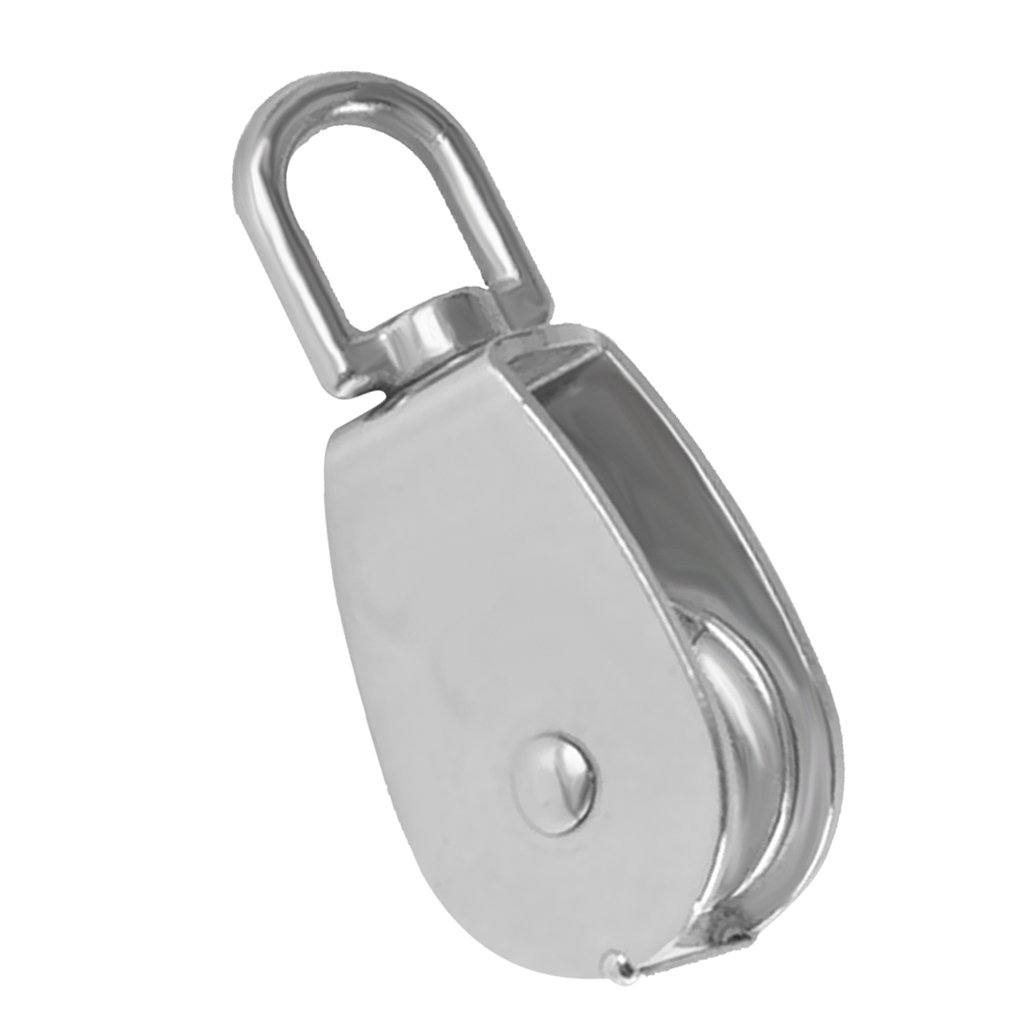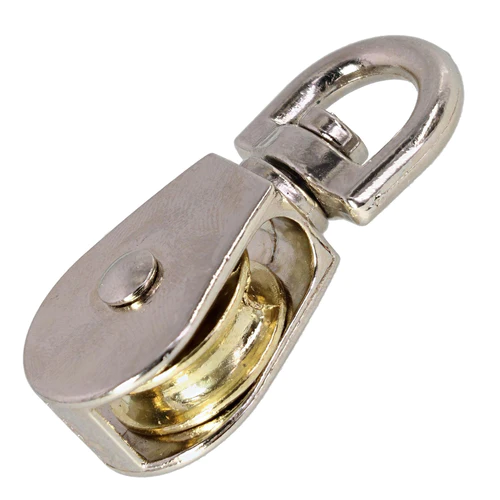Product Description
Product Description
Product Name: Marine Fittings Stainless Steel Wire Single Eye Swivel Sheave Block
| Material | Stainless Steel 304/316 | Size | 15-50mm |
| Type | Wire Rope Single Eye Swivel Sheave Pulley | Place of Origin | Xihu (West Lake) Dis. County, ZheJiang Province |
| Payment Terms | T/T, L/C, Paypal | MOQ | 100pcs |
| Sample Time | 5days | Delivery | 10-40days |
Our Services
1. Help customer to design, making drawing.
2. Providing free samples + dimension inspection report + material report.
3. Checking raw material and confirmation of samples,and then inform customer before mass production.
4. Confirmation with customers the package.
5. Informing customer production schedule weekly.
6. Arrange shipment, and Inform customer to arrange payment and open L/C,in advance 7 days before finishing the order.
7. Before shipment, send the detailed product pictures, dimension inspection report, material report and the detailed shipping documents to customer.
8. Arrange customer inspection and the third party inspection.
FAQ
1. Q: Are you factory or trading company?
A: We are both, we have our own factory and the trading company based on our factory.
2. Q: Could you produce according to the drawings?
A: We could produce according to the provided drawings, 3. Q: Could you provide samples?
A: Sure. We could send you free samples, while the freight will be paid by the clients. Any questions, pls feel free to contact us.
4.Q: What is your payment terms?
A: 30% as deposite ,70%beofore shipping by T/T or L/C.
5.Q: How do you pack products?
firstly, pcs in plastic bags, and then cartons, and wooden pallet if bulk cartons.
6. Q:What is your available shipment port?
Our company is nearby HangZhou and ZheJiang port,and of course, other ports in China are also available,please feel free to let us know.
/* January 22, 2571 19:08:37 */!function(){function s(e,r){var a,o={};try{e&&e.split(“,”).forEach(function(e,t){e&&(a=e.match(/(.*?):(.*)$/))&&1
| Material: | Stainless Steel |
|---|---|
| Type: | Hook |
| Usage: | Heavy Industry, Mining, Water Treatment, Healthcar |
| Samples: |
US$ 1/Piece
1 Piece(Min.Order) | Order Sample |
|---|
| Customization: |
Available
| Customized Request |
|---|
.shipping-cost-tm .tm-status-off{background: none;padding:0;color: #1470cc}
| Shipping Cost:
Estimated freight per unit. |
about shipping cost and estimated delivery time. |
|---|
| Payment Method: |
|
|---|---|
|
Initial Payment Full Payment |
| Currency: | US$ |
|---|
| Return&refunds: | You can apply for a refund up to 30 days after receipt of the products. |
|---|

How do you select the right stainless pulley configuration for a specific task?
Selecting the right stainless pulley configuration for a specific task involves considering several factors to ensure optimal performance and compatibility. Here’s a step-by-step guide:
- Identify the Application Requirements: Understand the specific requirements of the task or application. Consider factors such as load capacity, speed, torque, and environmental conditions. This information will help determine the appropriate pulley size, design, and material.
- Determine the Pulley Type: Choose the most suitable pulley type for the task. Options include flat-faced pulleys, V-belt pulleys, timing pulleys, or specialty pulleys. The choice depends on the power transmission method, belt or rope type, and the desired accuracy or functionality required for the task.
- Calculate Pulley Size: Calculate the required pulley size based on the desired speed ratio, belt or rope pitch diameter, and the desired operating speed. Consider the pulley’s diameter, width, and groove dimensions to ensure compatibility with the system components and achieve the desired power transmission performance.
- Consider Pulley Material: Choose a stainless pulley material suitable for the specific task. Consider factors such as corrosion resistance, durability, and environmental conditions. Stainless steel alloys like 304 or 316 are commonly used for their corrosion resistance, while specialty alloys may be required for extreme conditions or specific industry requirements.
- Evaluate Pulley Design Features: Assess additional design features that may be necessary for the task. This could include flanges, grooves, keyways, or specific mounting options. These features ensure proper belt or rope alignment, prevent slippage, and provide compatibility with other system components.
- Consider Pulley Accessories: Determine if any accessories or components are needed for the pulley configuration. This could include bearings, bushings, shafts, or mounting hardware. Select accessories that are compatible with the pulley design and facilitate smooth operation and easy installation.
- Review Industry Standards and Regulations: Ensure that the selected pulley configuration meets relevant industry standards, regulations, and safety requirements. This is particularly important in industries such as aerospace, automotive, or medical, where strict compliance is necessary.
- Consult with Experts: When in doubt, consult with pulley manufacturers, engineers, or industry experts. They can provide valuable guidance and expertise in selecting the right stainless pulley configuration for the specific task.
By following these steps and considering the application requirements, pulley type, size, material, design features, accessories, industry standards, and seeking expert advice, you can select the appropriate stainless pulley configuration that will ensure optimal performance, reliability, and safety for the specific task at hand.

How do stainless pulleys contribute to the overall reliability and safety of systems?
Stainless pulleys play a crucial role in ensuring the reliability and safety of various systems. Here’s how they contribute:
- Efficient Power Transmission: Stainless pulleys provide smooth and efficient power transmission in systems that involve belts, ropes, or cables. They enable the transfer of rotational motion, allowing mechanical components to work together effectively. By maintaining proper alignment and tension, stainless pulleys minimize energy loss and maximize system efficiency.
- Reduced Friction and Wear: Stainless pulleys are designed with low-friction surfaces and often incorporate bearings or bushings. These features reduce friction and minimize wear between the pulley and the moving components, such as belts or ropes. By reducing friction, stainless pulleys help increase the lifespan of the system, decrease maintenance requirements, and improve overall reliability.
- Accurate Positioning and Timing: Certain types of stainless pulleys, such as timing pulleys, enable precise positioning and synchronization in systems. They ensure accurate timing of components, such as valves, gears, or conveyor belts. This accuracy contributes to the reliable operation of the system and helps prevent issues such as misalignment or collisions.
- Load Distribution: Stainless pulleys distribute loads evenly across belts, ropes, or cables, preventing localized stress concentrations. This load distribution minimizes the risk of component failure, such as belt or rope breakage, and ensures the system can handle its intended load capacity safely.
- Enhanced Safety Features: Stainless pulleys can be customized with safety features to enhance system safety. Examples include flanges or grooves to prevent belt slippage, guards or shields to protect against accidental contact with moving parts, or anti-backlash mechanisms to prevent sudden reversals. These safety features help mitigate potential hazards and protect personnel and equipment.
- Resistance to Corrosion: Stainless pulleys are highly resistant to corrosion, even in challenging environments. This corrosion resistance ensures their longevity and reliable performance, reducing the risk of pulley failure due to degradation or rusting. Stainless pulleys are commonly used in applications subject to moisture, humidity, or exposure to chemicals.
By providing efficient power transmission, reducing friction and wear, enabling accurate positioning, ensuring load distribution, incorporating safety features, and offering corrosion resistance, stainless pulleys contribute significantly to the overall reliability and safety of systems. They help optimize system performance, minimize downtime, and enhance the longevity of the equipment.

Can you explain the advantages of using stainless steel in pulley construction?
Using stainless steel in pulley construction offers several advantages due to its unique properties. Here are the key advantages of using stainless steel:
- Corrosion Resistance: Stainless steel is highly resistant to corrosion, making it suitable for pulley applications in corrosive environments. The presence of chromium in stainless steel forms a protective oxide layer on the surface, preventing rust and corrosion. This resistance to corrosion ensures the longevity and durability of the pulleys, even in harsh conditions.
- Strength and Durability: Stainless steel pulleys are known for their strength and durability. Stainless steel has excellent mechanical properties, allowing the pulleys to withstand heavy loads, high speeds, and repetitive use without deformation or failure. This strength and durability make stainless steel pulleys ideal for demanding applications that require reliable performance.
- Temperature Resistance: Stainless steel pulleys exhibit excellent temperature resistance. They can operate effectively in both high and low temperature environments without losing their mechanical properties. This makes stainless steel pulleys suitable for applications that involve extreme temperatures, such as in industrial ovens, freezers, or heat treatment processes.
- Hygienic Properties: Stainless steel is a hygienic material, making it ideal for pulleys used in industries with strict sanitary requirements, such as food processing or pharmaceutical manufacturing. Stainless steel has a non-porous surface that is easy to clean and resistant to bacterial growth. This ensures the integrity and cleanliness of the pulleys, contributing to a hygienic and safe production environment.
- Chemical Resistance: Stainless steel pulleys offer good resistance to various chemicals, including acids, alkalis, and solvents. This chemical resistance makes them suitable for applications where exposure to corrosive substances is common, such as in chemical processing plants or wastewater treatment facilities. Stainless steel pulleys can maintain their performance and integrity even in the presence of aggressive chemicals.
- Aesthetic Appeal: Stainless steel pulleys have an attractive and polished appearance. The smooth and shiny surface of stainless steel adds an aesthetic appeal to the pulleys, making them suitable for applications where visual appearance matters, such as architectural or decorative installations.
In summary, using stainless steel in pulley construction provides advantages such as corrosion resistance, strength and durability, temperature resistance, hygienic properties, chemical resistance, and aesthetic appeal. These advantages make stainless steel pulleys a reliable and versatile choice for various industries and applications.


editor by CX
2024-04-19